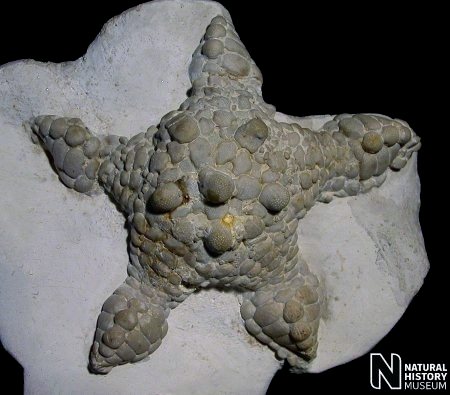 A A |
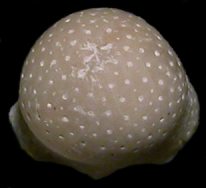 B B |
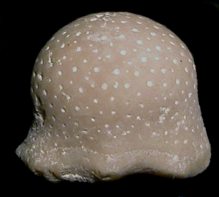 C C |
|
Manfredaster bulbiferus |
Large, robust and highly distinctive Asteroids from the White Chalk. The bulbous ossicles from the crown are the most readily recognised ossicles, and these occur with some frequency, but it is the swollen and heavily armoured arm-tips which define this taxon. Articulated material is rarely encountered in the field, but well preserved specimens are relatively common in museum collections. Manfredaster was formerly known as Aspidaster.
 A A |
 B B |
 C C |
1). Manfredaster bulbiferus; (A) Exceptionally well preserved individual, x1.0, White Chalk, Charlton Kent, Ogle Collection, BMNH (British Museum (Natural History) London) E344a. This specimen also has two well preserved Valettaster argus associated (see the whole specimen); (B) top view of an isolated primary interadial and (C) lateral (side) view showing the distinctive bulbous profile (x6.5, west of Newhaven, near Peacehaven, Newhaven Chalk Formation, Randell Collection, RR1449). Image (A) © 2005 The Natural History Museum, by kind permission.
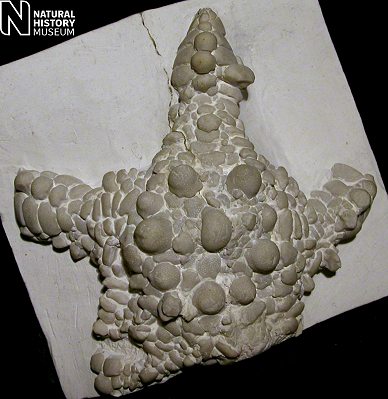 A A |
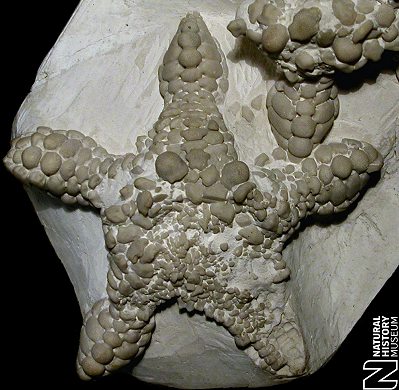 B B |
2). Exceptionally well preserved individuals; (A) x1.4, White Chalk, Charlton Kent, Simmons Collection, BMNH (British Museum (Natural History) London) E5042; (B) x1.2, Bromley, Kent, Simmons Collection, BMNH 48748. Images © 2005 The Natural History Museum, by kind permission.
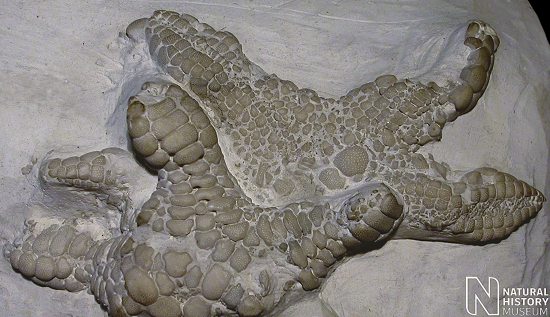
3). Two well preserved individuals displaying both the aboral (left-hand specimen) and oral (right-hand specimen) surfaces; x1.6, Bromley, Kent, Simmons Collection, BMNH (British Museum (Natural History) London) 48748. Image © 2005 The Natural History Museum, by kind permission.
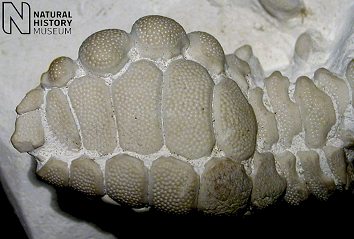
4). Well preserved arm viewed from the side (laterally), displaying the bulbous profile; x2.4, Micheldever, Hampshire, Blackmore Collection, BMNH (British Museum (Natural History) London) E20315. Image © 2005 The Natural History Museum, by kind permission.
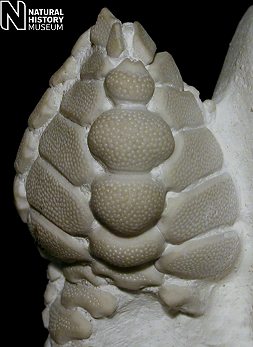 A A |
 B B |
5). (A) Aboral and (B) oral views of the above arm (x2.4). Images © 2005 The Natural History Museum, by kind permission.

6). Low angle view of a complete specimen, demonstrating the domed and heavily armoured nature of the central disc, the constricted nature of the arms, and the markedly swollen form of the arm-tips; x1.4, White Chalk, Charlton Kent, Ogle Collection, BMNH (British Museum (Natural History) London) E344a. Image © 2005 The Natural History Museum, by kind permission.
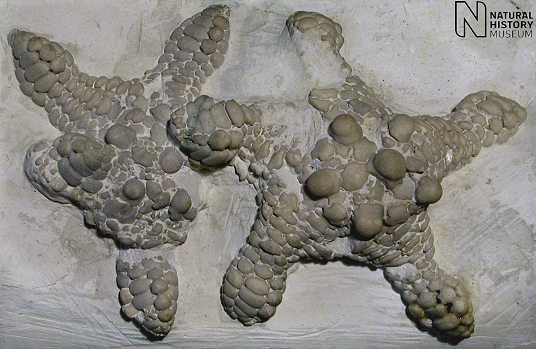
7). Two associated individuals; x1.2, Bromley, Kent, Simmons Collection, BMNH (British Museum (Natural History) London) 48748. Image © 2005, The Natural History Museum, by kind permission.
 A A |
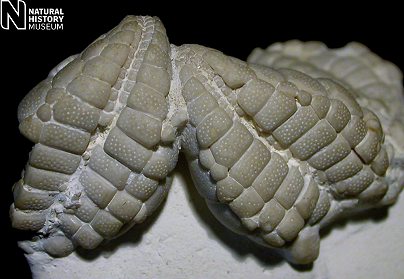 B B |
8). A well preserved individual, but with somewhat dislocated arms; (A) General view of the aboral surface (x1.6); (B) Oral views of two arm tips (3.1). White Chalk, Bromley, Kent, Simmons Collection, BMNH (British Museum (Natural History) London) E5040. Images © 2005 The Natural History Museum, by kind permission.
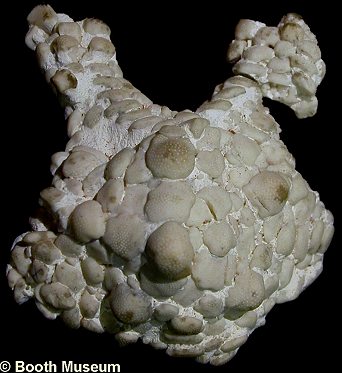 A A |
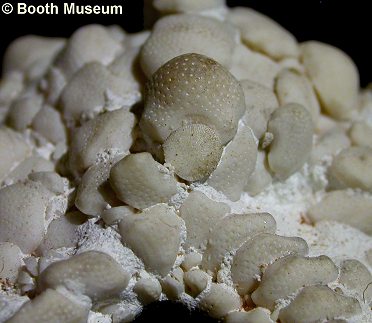 B B |
9). A partial specimen with a well preserved central disc; (A) General view (x2.0); (B) Detail showing the madreporite situated beneath a primary interadial (x4.2). In the collections of the Booth Museum, BMB 008634, by kind permission of John Cooper).
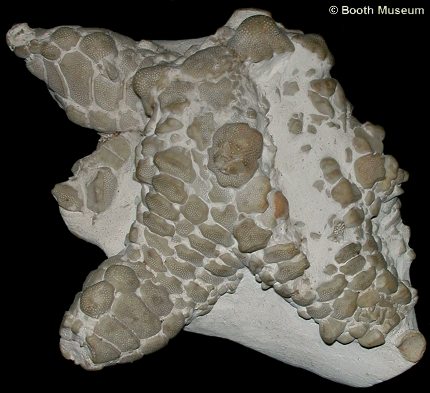 |
10). Aboral view of a moderately large specimen, the characteristic 'chain-mail' of the arms is well displayed (x1.6, White Chalk, 'Woolwich', Greater London, Willett Collection, Booth Museum, BMB 007807, by kind permission of John Cooper).
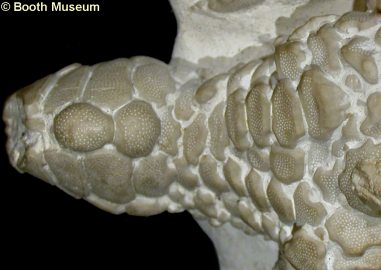 A A |
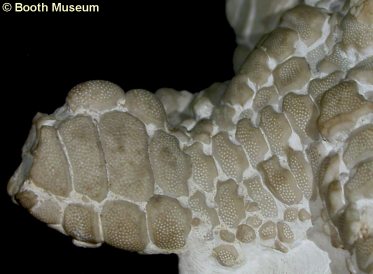 B
B |
11). An exceptionally preserved arm from the above individual, displaying very well the swollen nature of the arm-tip which characterises Manfredaster (x2.3); (A) Aboral (top) view; (B) lateral (side) view.
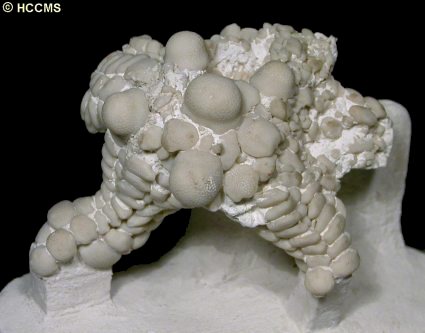 A A |
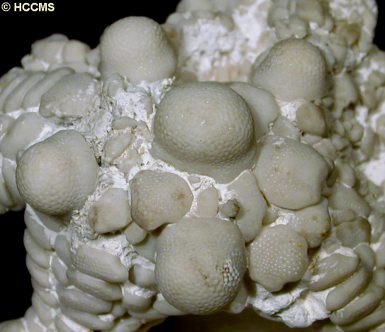 B
B |
12). Manfredaster bulbiferus, a moderately small and very well preserved individual (Hampshire?, White Chalk, HCCMS (Hampshire County Council Museum's Service) collection, stored at Gosport Museum, G1981.191, by kind permission of Dave Kemp, HCCMS); (A) general aboral view (x1.5); (B) detail of the disc and the crown of highly bulbous ossicles (2.5).

13). Manfredaster cf. bulbiferus, a moderatley large individual preserved in a nodule of flint. Uniquely, the ossicles of the crown are flat and plate-like, rather than protruding and bulbous (x2.1, flint, White Chalk, Brighton, Sussex, Willett Collection, Booth Museum, BMB 007836, by kind permission of John Cooper).
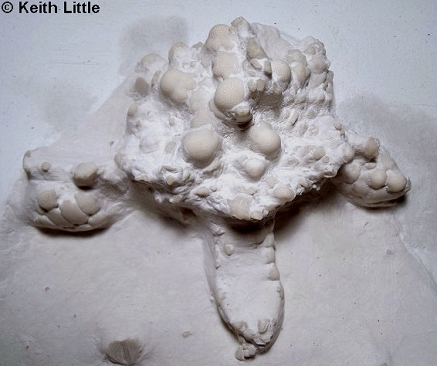 A A |
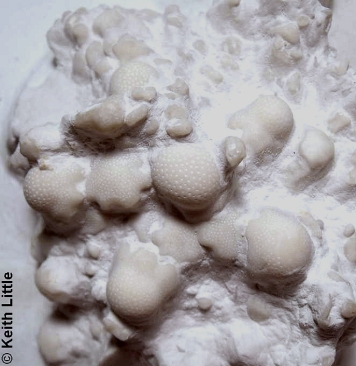 B
B |
14). Manfredaster bulbiferus, a new semi-complete example. Though this species is well represented in the major museum collections, new specimens of this quality are exceptionally scarce (Seaford Chalk, Thanet Coast, Kent, in the collection of Keith Little): (A) overview of specimen (x1.3); (B) Detail of central disc (x3.0). Images © 2010 Keith Little, by kind permission.
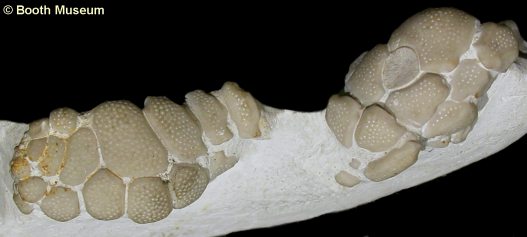
15). Manfredaster cf. bulbiferus; partial individual, displaying the swollen arm tip in side profile. The section of crown which contains the madreporite is beautifully preserved (x3, White Chalk, 'Seaford', Willett Collection, Booth Museum, BMB 007831, by kind permission of John Cooper).
 A A |
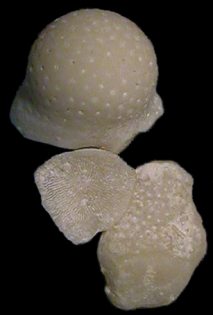 B B |
16). Madreporites; (A) detail of the above specimen; the madreporite slots into the base of the primary interadial (x5); (B) same view of part of a small individual reconstructed from a pellet (x7, Manfredaster bulbiferus, Peacehaven, Newhaven Chalk Formation, Randell Collection, RR1704).

17). A stunning but highly suspicious starfish multi-block. Victorian fossil dealers are notorious for their forged specimens, though the style preservation and other factors suggest that these specimens were originally associated in some way, if not in the manner presented. x0.5, Bromley, Kent, Simmons Collection, BMNH (British Museum (Natural History) London) 48748. Image © 2005, The Natural History Museum, by kind permission